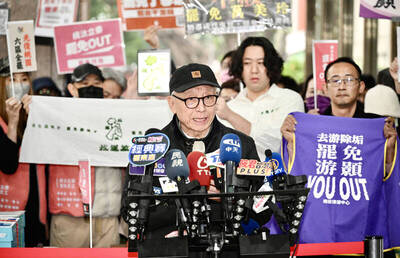An international scheme to tax the wealth of the world’s 3,000 billionaires is technically feasible and could net up to US$250 billion a year in extra revenue, a new report says.
A study by the French economist Gabriel Zucman concluded that progress in finding ways to tax multinational corporations meant it was now possible to levy a global tax on individuals — even if not every country agreed to take part.
Zucman prepared the report after being invited by Brazil — which now holds the presidency of the G20 group of developed and developing nations — to examine ways of increasing the low levels of tax currently paid by the super-rich.

Photo: AFP
“There is overwhelming public support for this idea,” Zucman said at the report’s launch. “Ten years ago nobody believed 130 countries would support a minimum tax on multinationals. It was thought of as utopian.”
The report said billionaires were currently paying an average of 0.3 percent tax on their wealth — less than the rates paid by workers. Zucman said the average wealth of the top 0.0001 percent of individuals had grown by 7.1 percent a year on average between 1987 and this year, increasing the share of global wealth of billionaires from 3 percent to 14 percent.
Describing his plan as a top-up to income tax so that billionaires paid an annual tax bill worth at least 2 percent of their wealth, Zucman said progressive taxation was a “key pillar of modern societies.”
International cooperation was needed to prevent a “race to the bottom,” he said, but it was not necessary for every country to sign up for the idea to get off the ground. The US opposes a global tax on wealth, although Zucman said US President Joe Biden’s budget proposal to tax America’s super-rich was consistent with his plan.
Zucman said valuing the wealth of billionaires would be relatively simple because most of it was held in the form of shares. His report said it could be enforced successfully even if all countries did not adopt it, by strengthening current exit taxes (levies on rich people taking their money to a non-participating jurisdiction) and implementing “tax collector of last resort.”
This would involve extending to individuals rules that allow participating countries to tax non-participating countries’ undertaxed multinationals.
The proposal will be discussed at next month’s G20 meeting of finance ministers in Rio de Janeiro.
Oxfam International’s interim executive director Amitabh Behar said: “This is a sensible and serious proposal that is in every government’s strategic economic interest. All G20 countries should support Brazil’s push to secure the first-ever global deal to tax the super-rich.”
Phil White, member of Patriotic Millionaires UK, said: “Zucman’s report shows that a coordinated, international approach to taxing the super-rich is the sensible and fair way to address the extreme concentration of wealth.
“Addressing billionaire wealth should be viewed as the initial step; if we aim to safeguard democracy from the corrosive effects of extreme wealth, then multimillionaires like me should also be prepared to pay more – and take pride in contributing their fair share.”
Extending the plan to those with wealth in excess of US$100 million would raise an additional US$100 billion TO US$140 billion a year, Zucman said.

The Democratic Progressive Party (DPP), Chinese Nationalist Party (KMT), and the country’s other political groups dare not offend religious groups, says Chen Lih-ming (陳立民), founder of the Taiwan Anti-Religion Alliance (台灣反宗教者聯盟). “It’s the same in other democracies, of course, but because political struggles in Taiwan are extraordinarily fierce, you’ll see candidates visiting several temples each day ahead of elections. That adds impetus to religion here,” says the retired college lecturer. In Japan’s most recent election, the Liberal Democratic Party lost many votes because of its ties to the Unification Church (“the Moonies”). Chen contrasts the progress made by anti-religion movements in

Taiwan doesn’t have a lot of railways, but its network has plenty of history. The government-owned entity that last year became the Taiwan Railway Corp (TRC) has been operating trains since 1891. During the 1895-1945 period of Japanese rule, the colonial government made huge investments in rail infrastructure. The northern port city of Keelung was connected to Kaohsiung in the south. New lines appeared in Pingtung, Yilan and the Hualien-Taitung region. Railway enthusiasts exploring Taiwan will find plenty to amuse themselves. Taipei will soon gain its second rail-themed museum. Elsewhere there’s a number of endearing branch lines and rolling-stock collections, some

This was not supposed to be an election year. The local media is billing it as the “2025 great recall era” (2025大罷免時代) or the “2025 great recall wave” (2025大罷免潮), with many now just shortening it to “great recall.” As of this writing the number of campaigns that have submitted the requisite one percent of eligible voters signatures in legislative districts is 51 — 35 targeting Chinese Nationalist Party (KMT) caucus lawmakers and 16 targeting Democratic Progressive Party (DPP) lawmakers. The pan-green side has more as they started earlier. Many recall campaigns are billing themselves as “Winter Bluebirds” after the “Bluebird Action”

Feb 24 to March 2 It’s said that the entire nation came to a standstill every time The Scholar Swordsman (雲州大儒俠) appeared on television. Children skipped school, farmers left the fields and workers went home to watch their hero Shih Yen-wen (史艷文) rid the world of evil in the 30-minute daily glove puppetry show. Even those who didn’t speak Hoklo (commonly known as Taiwanese) were hooked. Running from March 2, 1970 until the government banned it in 1974, the show made Shih a household name and breathed new life into the faltering traditional puppetry industry. It wasn’t the first